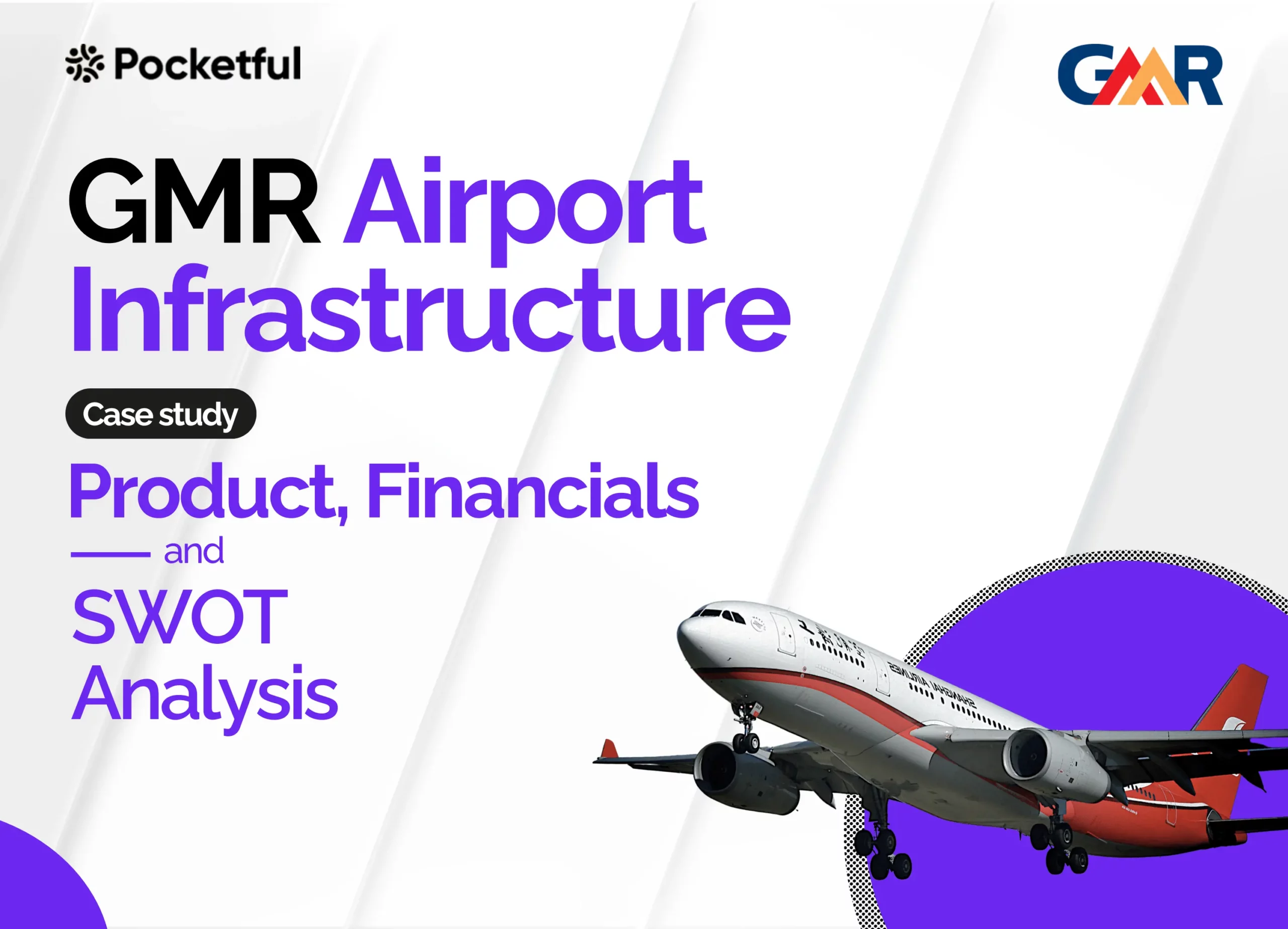| Type | Description | Contributor | Date |
|---|---|---|---|
| Post created | Pocketful Team | Jun-10-24 | |
| Add new links | Nisha | Feb-24-25 |

- Blog
- gmr airports infrastructure case study
GMR Airports Infrastructure Case Study

There is an organization that has airports, energy, transportation, and urban infrastructure all under one roof. We are talking about GMR Group, a company that has undertaken world-class projects both domestically and Internationally.
Let’s explore GMR Airports Infrastructure Limited’s rigorous and committed path while scrutinizing its finances, SWOT analysis, vision, and many other aspects.
GMR Airports Overview
GMR is an Indian multinational conglomerate headquartered in New Delhi. It comprises several companies, including GMR Infrastructure, GMR Energy, GMR Enterprises, and GMR Airports. The Group has implemented several infrastructure projects in India and is the only Indian airport developer to own and develop airports outside India.
GMR Airports History
GMR Airports Infrastructure Ltd. was established in Andhra Pradesh on May 10, 1996, as Varalakshmi Vasavi Power Projects Limited. They later rebranded themselves as GMR Infrastructure Limited on July 24, 2000.
GMR Airports Infra develops, constructs, maintains, and manages highways and airports. The company entered the airport business in the early 2000s and is currently among the top five airport developers in the world. It oversees multiple airports, including Delhi International Airport, Hyderabad International Airport, and Manohar International Airport in Goa.

Business Model of GMR Airports
GMR Airports Infrastructure operates on a focussed business model, which revolves heavily around the airline industry. The company generates 26% of its revenue from aeronautical services. This comprises airlines’ fees for landing, taking off, and using airport facilities. The majority of revenue, 57%, is generated from non-aeronautical services. These services include retail and concession leasing within airport terminals, parking fees, ground transportation services, and advertising. Additionally, 16% of the revenue comes from other operating income.
Read Also: Gillette India Case Study
GMR Airports Financial Highlights
Balance Sheet
| Particulars | March 31, 2024 | March 31, 2023 |
| Non-current assets | 40,642.22 | 35,233.37 |
| Current assets | 8,041.84 | 8,878.06 |
| Non-current liabilities | 41,990.79 | 34,063.85 |
| Current liabilities | 7,561.93 | 9,078.73 |
The graph indicates a consistent growth in non-current liabilities and assets. This showcases a consistent financial position of the company.
Income Statement
| Particulars | March 31, 2024 | March 31, 2023 |
| Revenue from Operations | 8,755 | 6,674 |
| Total Expenses | 5,789 | 4,968 |
| Operating Profit | 2,966 | 1,745 |
| Profit before tax | -635 | -726 |
The income statement reveals a growing revenue base that led to an increase in operating profit. However, the organization still faces a loss. This could indicate towards the company’s inability to pull through a profit.
Cash Flow Statement
| Particulars | March 31, 2024 | March 31, 2023 |
| Cash Flow from Operating Activities | 3,880.10 | 2,199.23 |
| Cash Flow from Investing Activities | -5,788.40 | -2,322.35 |
| Cash Flow from Financing Activities | 466.54 | 1,731.25 |
The graph showcases a growing CFO, which indicates that the company operations are stable. A decrease in CFI is also visible, which shows the company’s heaving outflows in investments.
GMR Airports SWOT Analysis

Strengths
- GMR Airports Infrastructure Limited operates in diverse industries like energy, transportation, and urban infrastructure. This diversity offers chances for success in several industries while reducing the risks of reliance on a single one.
- The company has achieved global recognition due its large-scale projects in India. This recognition has proved to bring in many projects across the globe.
- A solid balance sheet reflects the company’s ability to take on even more projects.
Weaknesses
- As seen from the negative net income in the income statement, GMR Infra has been losing money lately. Potential difficulties in controlling costs and producing long-term profitability are highlighted by this trend.
- Its large non-current liabilities indicate heavy reliance on debt finance to fund its operations and expansion plans. High debt levels may impact creditworthiness and raise financial risk.
Opportunities
- With the need for infrastructure and aviation expanding, GMR Airports Infra Limited might investigate growth prospects in new markets.
- By taking advantage of the global demand for modern airport facilities, GMR Airports can increase its chances of winning contracts for these projects and solidify its place as an industry leader.
Threats
- The airport infrastructure industry is highly competitive, with established players and new entrants. Intense competition can exert pressure on pricing, margins, and project acquisition.
- Due to the recent rapid technological advancement, continuous investment in new technologies is necessary; however, this can be risky and financially taxing if not handled carefully.
- Airport infrastructure companies, especially those with global operations, may face operational challenges due to recent geopolitical tensions, trade disputes, and regulatory changes about immigration and security measures.
Read Also: Waaree Energies Case Study
Conclusion
GMR Airports Infrastructure Limited is a prime example of a dynamic, multifunctional company that works in various industries, such as energy, transportation, urban infrastructure, and airports. Its unique business strategy and robust global presence establish it as a prominent participant in the infrastructure sector.
However, to stay competitive, GMR Airports Infrastructure Limited must constantly invest in new technologies, which presents difficulties given its high debt load and recent financial setbacks. The company’s sustained growth depends on its ability to navigate fierce competition and manage regulatory dependencies.
Frequently Asked Questions (FAQs)
In the infrastructure sector, what sets GMR Airports Infrastructure Limited apart?
GMR Airports Infrastructure Limited is notable for its cutting-edge methods of managing airports and building infrastructure. The Company guarantees excellent service and efficiency by fusing cutting-edge technology and sustainable practices, which positions it as a global leader in the sector.
Where is GMR Airports Infrastructure Limited’s headquarters?
GMR Airports Infrastructure Limited’s headquarters are situated in New Delhi, India.
Which airports are some of GMR Airports Infrastructure Limited’s flagships?
The Company manages some of India’s most renowned airports, including Hyderabad International Airport and Delhi International Airport. Its oversight of operations at Kualanamu International Airport in Indonesia and Mactan Cebu International Airport in the Philippines demonstrates its worldwide reach.
Is GMR Airports Infrastructure Limited publicly listed?
GMR Airports Infrastructure is listed on BSE and NSE.
What does GMR Airports Infrastructure Limited do?
GMR Airports Infrastructure Limited develops and manages airports. It is part of the larger GMR Group, which also works in energy, transportation, and urban infrastructure.
Disclaimer
The securities, funds, and strategies discussed in this blog are provided for informational purposes only. They do not represent endorsements or recommendations. Investors should conduct their own research and seek professional advice before making any investment decisions.